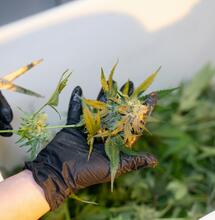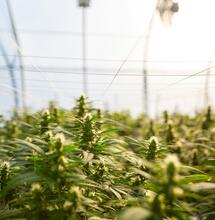Top Tips For Spring
_30.jpg)
It is everybody's favorite time of the year, when April rolls on and you are treated to longer days and warmer nights. Spring is already here and now is the best time to consider an outdoor crop. Understanding what you need to prepare for the buildup to the fall and shorter nights, is the difference between Gold and Bronze. Below are my tips on what to think about when planting in the outdoors and how to make the most out of the weather.
It is everybody's favorite time of the year, when April rolls on and you are treated to longer days and warmer nights. Spring is already here and now is the best time to consider an outdoor crop. Understanding what you need to prepare for the buildup to the fall and shorter nights, is the difference between Gold and Bronze. Below are my tips on what to think about when planting in the outdoors and how to make the most out of the weather.
Location:
This is one of the biggest factors in outdoor growing. The difference in location between a site which receives a few more hours than another is unequivocal. If you have the luxury of planting outdoors in your own private back garden or neighbors, then locate south and work out over the next few months the direction the sun will change. This way the plant will always receive sunlight until the last moment as there is nothing worse to watch than a plant in the shade, as everywhere else around it receives sun after a certain time due to over shadowing buildings.
Genetics:
Run with an Indica variety or if you think you can get good yields, push for a haze hybrid. Many plants will do well until August then may struggle to meet the plant's demands in terms of sunlight and lumens it is receiving. A good style Indica will ripen with dense hard buds after 60 days. Many growers in the UK do not have good success with Sativa dominant strains and are often left with miniature yields of tiny buds.
Start The Seeds Off Indoors:
Give your seeds the best start in life before they must embrace the real world. Use an L.E.D or veg light to start them for at least the first 2 weeks, before placing outdoors into the medium with the plastic cups over. Remember to only veg them with the same amount of hours of daylight outside. The plants will begin to notice the days are getting longer so do not give them 18 hours for example and then place them outside where you may receive 13.5 hours. I have witnessed many clones that were grown under 18-24 hours of light and when placed outdoors to grow, began to flower. The plants do re veg themselves, but it is an unwanted process as a grower.
Keep Pots Off The Floor:
It is a good idea to do this indoors and especially outdoors. The main reason for doing it is not just to keep the roots off cold concrete floors, but to also allow air to flow around the base of the pot and roots. Drainage also becomes much easier to observe and check for runoff and test. If you actually add an inch of clay balls to the bottom of the medium this will help drainage and air movement considerably.
Growing Phase:
Once you plant your young seedling outdoors, consider the size that a full-scale plant will require to grow happily. This is when you should consider plant heightand begin to create as much stealth now to avoid doing too much later on. The seedlings may be small now, but they will grow from April until August so be prepared for a big plant. The days will begin to get shorter towards the end of August and start of September.
Plant Security:
The UK is notorious for slugs and snails. The slugs come out at night and cause havoc amongst anything green and growing. A really good way to ensure that your plant stays in perfect shape for the first three weeks is to cover them with plastic clear cups with very small air holes throughout. This will also act as a mini propagator so you can start seeds directly into the medium with a small cup over and leave outside. As the plant gets bigger increase the size of the cup. This is a great defense against any insect which cannot eat through plastic!
Medium and Nutrients to Use:
Invest well in the medium you will use and it will reward you heavily. Before you drive to your local garden centre and fill the car with low grade soil, think about what the plant needs and what you can do to cover every part of the growing phase feed requirements. Drainage is a huge part with outdoor growing and over a five month period the roots and medium need good air and water movement. Below is a list of different mediums and additives you can use.
- Soil
- Clay Balls
- Bat Guano
- Coco
- Rockwool Rooting Cubes
- Peat Moss
- Perlite
- Worm Hummus
- Old Plant Roots
- Vermiculite
Plant Count:
When you think of the plant count, it is easy to become excited and begin germinating a ten pack of fems. Growing a small number can be better if you can grow strong bushy plants to begin with. You may get the same results growing five plants as your neighbour next door who grows just one. Dedicating a large space to one plant will surely result in a large stocky heavy producer, which will not be fighting for the sunlight as the other may do. The benefits of growing more than one is more choice and different flavors and highs, yet remember if you are only growing one strain anyhow, then less is more!
Heated Floors:
A cheap and effective way to solve the problem of cold floors inside greenhouse or outdoors, is to place a heating cable in waves on the floor and to cover to avoid tripping. If you have a large tray these are great as the tray will remain heated on the basis the heating cable is plugged in. With an extension cord you can connect power to the greenhouse in a discreet way whilst providing warm temperatures of the roots. Good luck with the first part of growing your seedlings into tough bushy plants. I hope after reading this article, you now have good ideas and can really get the most out of your outdoor patch! Peace.



